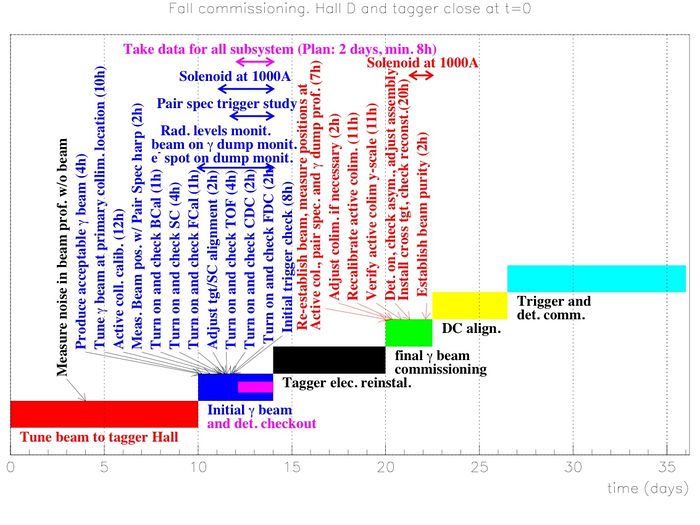Spring 2015 Commissioning Plan
From Hall D Ops Wiki
This page gives the run plan for the Spring 2015 commissioning. It is a controlled document that can be edited only by E. Chudakov, E. Smith or A. Deur. Suggestions and comments should be send to them.
Items in pink indicate missing information.
General Information
This document describes the run plan and procedures for the Hall D spring 2015 commissioning.
- Schedule for the Spring 2015 run. (Dates are according to the October 2014 - December 2015 Memo and Schedule (20141001). They will be updated if necessary in the run coordination meeting pages)
- Feb. 13 - Feb. 26: Beam restoration (13 days)
- Feb. 27 - March 26: Accelerator development. Physics running conditions are similar to Fall 2014: Accelerator has priority. Possible running for Halls A/B/D.
- Apr. 3 - May 4: Physics run (Halls A/B/D).
- Goals for the Spring 2015 run.
- Commission the new Hall D equipment:
- LH2 target, high priority. ( Expected time ?? )
- Diamond radiator/goniometer, high priority. ( Expected time ?? )
- Accelerator clock, low priority. ( Expected time ?? )
- Total Absorption Counter (TAC), low priority. ( Expected time ?? )
- Photon beam polarimeter, low priority. ( Expected time ?? )
- Establish DAQ operation in Block Mode with ~ 20 kHz rate.
- Complete detector calibration/alignment.
- Complete trigger optimization.
- Commission beam stability feedbacks.
- Expected Staffing and responsibilities:
- The Run Coordinator (RC, Alexandre Deur) oversees the commissioning.
- The Physics Division Liaison (PDL, TBD ) and Hall D Work Coordinator/Safety Warden (T. Carstens) verify that the proper safety rules are followed.
- The Analysis Coordinator (TBD) will organize the off-line analysis effort.
- Individuals responsible for each commissioning step are named in the section describing the step. They are also responsible for logging in the ELog the summary of how the step proceeded and other relevant information.
- Shifts
- 2 persons per shift, one with solenoid training
- Coordination Activities:
- The RC will attend the MCC meetings at 7:50am and 8:00am and the weekly MCC meeting (Wednesday, 1:30pm). The PDL will attend the weekly MCC meeting.
- Daily run meetings broadcasted on Bluejeans will occur at 10:30am in the counting house conference room. The Run Coordinator will be responsible for organizing and chairing the meeting.
- Useful links:
- Accelerator schedule
- Links to beam parameters/radiation level monitoring:
- Last 8-hours plots showing 1-minute, 10-minute, and hourly averages
- Same but Last 24-hours
- Same but Last 72-hours
- Week, month, and quarter (3 months) plots also exist, with similar web addresses.
- A map of the radiation monitors

Beam Configuration Parameters
- Energy of Beam: expected ~ 11 GeV
- Solenoid current up to 1300A (running condition).
- Beam current for Photon beam operations: CW 50 na-1 μA.
- Radiators:
- Nominal: Diamond.
- Other available:
- 1.5 µm Al (1.7·10-5 R.L.)
- 10 µm Al (11.2·10-5 R.L.)
- 30 µm Al (33.7·10-5 R.L.)
- Collimator hole: 5 mm diameter nominally. May run on the 3.4 mm once priority plans are completed.
- Main target: LH2 cryogenic target
- Backup targets are are:
- 10mm thick disk (3.19 cm diameter) of CH2 (HDPE, high density polyethylene, density 0.93-0.97 g/cm3 ), 0.95 g/cm2, ~1.2% R.L.
- 2mm thick disk (3.19 cm diameter) CH2 (HDPE)
- 2mm thick inside a 20mm diameter area and 7mm thick outside (HDPE)
- 3.4mm thick graphite (3.19 cm diameter) disk, 0.75 g/cm2, 1.8% R.L.
- Al. cross made of 1.59 mm diameter wires
- 1cm long Al. cylinder with an equilateral triangle hole inside. The triangle edge lengths are 2.5 cm
- Backup targets are are:
Run Plan
Commissioning time chart:
Commissioning time chart. Time t=0 corresponds to the Hall being locked-up for beam tunning. With the present schedule, it is sometime in the first half of Oct. The horizontal scale is the time during which beam is available (in other word, it would be the real time with 100% of beam efficiency). The task time estimates given on the plot have 100% contingency.